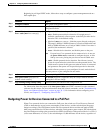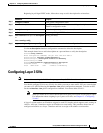
12-31
Catalyst 2960 and 2960-S Switch Software Configuration Guide
OL-8603-09
Chapter 12 Configuring Interface Characteristics
Configuring Ethernet Interfaces
Beginning in privileged EXEC mode, follow these steps to configure a power management mode on a
PoE-capable port:
For information about the output of the show power inline user EXEC command, see the command
reference for this release. For more information about PoE-related commands, see the “Troubleshooting
Power over Ethernet Switch Ports” section on page 38-13. For information about configuring voice
VLAN, see Chapter 15, “Configuring Voice VLAN.”
Budgeting Power for Devices Connected to a PoE Port
When Cisco powered devices are connected to PoE ports, the switch uses Cisco Discovery Protocol
(CDP) to determine the actual power consumption of the devices, and the switch adjusts the power
budget accordingly. The CDP protocol works with Cisco powered devices and does not apply to IEEE
third-party powered devices. For these devices, when the switch grants a power request, the switch adjusts
the power budget according to the powered-device IEEE classification. If the powered device is a Class 0
(class status unknown) or a Class 3, the switch budgets 15,400 milliwatts for the device, regardless of
Command Purpose
Step 1
configure terminal Enter global configuration mode.
Step 2
interface interface-id Specify the physical port to be configured, and enter interface
configuration mode.
Step 3
power inline {auto [max max-wattage] |
never | static [max max-wattage]}
Configure the PoE mode on the port. The keywords have these meanings:
• auto—Enable powered-device detection. If enough power is
available, automatically allocate power to the PoE port after device
detection. This is the default setting.
• (Optional) max max-wattage—Limit the power allowed on the port.
The range is 4000 to 15400 milliwatts on a Catalyst 2960 switch and
4000 to 30000 milliwatts on a Catalyst 2960-S switch. If no value is
specified, the maximum is allowed.
• never—Disable device detection, and disable power to the port.
Note If a port has a Cisco powered device connected to it, do not use
the power inline never command to configure the port. A false
link-up can occur, placing the port into an error-disabled state.
• static—Enable powered-device detection. Pre-allocate (reserve)
power for a port before the switch discovers the powered device. The
switch reserves power for this port even when no device is connected
and guarantees that power will be provided upon device detection.
The switch allocates power to a port configured in static mode before it
allocates power to a port configured in auto mode.
Step 4
end Return to privileged EXEC mode.
Step 5
show power inline [interface-id |
module switch-number]
The module keyword is applicable only on Catalyst 2960-S switches
running the LAN base image.
Step 6
copy running-config startup-config (Optional) Save your entries in the configuration file.


















